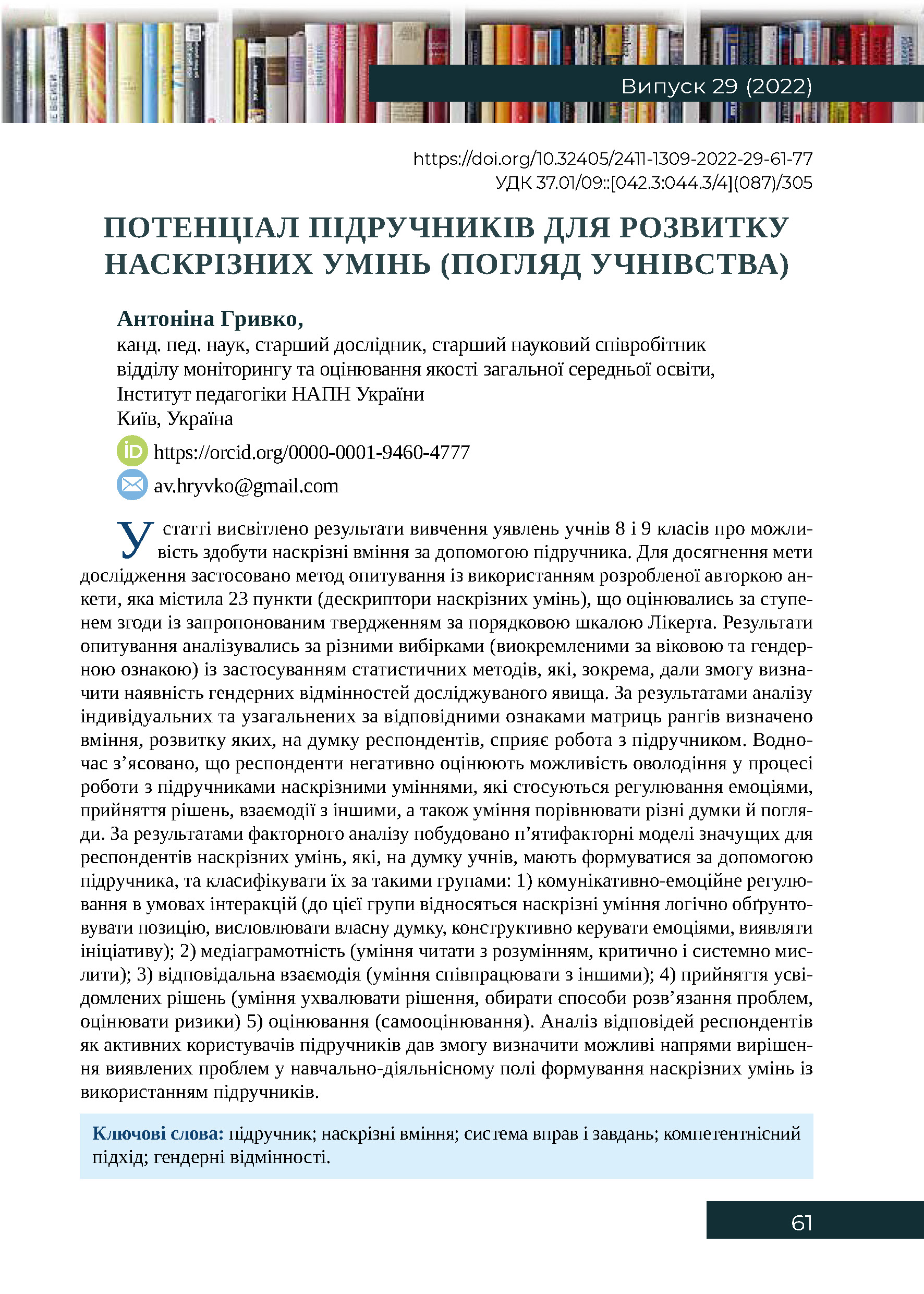The Potential of Textbooks for the Development of Transversal Skills (in the Imagination of Apprenticeship)

Published 2023-02-06
Keywords
- textbook,
- cross-cutting skills,
- system of exercises and tasks,
- competency-based approach,
- gender differences
How to Cite

This work is licensed under a Creative Commons Attribution-NonCommercial-ShareAlike 4.0 International License.
Abstract
The article highlights the results of studying the ideas of 8th and 9th-grade students about the possibility of acquiring cross-cutting skills with the help of a textbook in a generalized sense. To achieve the goal of the research, a survey method was used using a questionnaire developed by the author, which contained 23 items (descriptors of transversal skills), which were evaluated by the degree of agreement with the proposed statement on a Likert ordinal scale. The results of the survey were analyzed by different samples (separated by age and gender) using statistical methods, which, in particular, made it possible to determine the presence of gender differences in the studied phenomenon. According to the analysis of the individual and generalized rank matrices based on the relevant features, the skills, the development of which, according to the respondents, is facilitated by working with the textbook, have been determined. At the same time, it was found that the respondents negatively evaluated the possibility of mastering transversal skills related to the regulation of emotions, decision-making, interaction with others, as well as the ability to compare different opinions and views in the process of working with textbooks. Based on the results of the factor analysis, five-factor models of cross-cutting skills significant for the respondents, which, according to the students, should be formed with the help of the textbook, were built. They were separated into the following groups (classified): 1) communicative and emotional regulation in the conditions of interactions (to this group include comprehensive skills to logically substantiate a position, express one's own opinion, constructively manage emotions, show initiative); 2) media literacy (ability to read with understanding, think critically and systematically); 3) responsible interaction (ability to cooperate with others); 4) informed decision-making (ability to make decisions, choose ways to solve problems, assess risks) 5) evaluation (self-evaluation). The analysis of the answers of the respondents as active users of textbooks made it possible to determine the directions of solving the identified problems in the educational and activity field of forming cross-cutting skills with the use of textbooks.
Downloads
References
- Гривко, А.В., Ситник, О.В. (2017). Трансформації підручника як сучасного медіа в аспекті формування в учнів читацьких умінь. Проблеми сучасного підруника, 19. 92–101. (96‒97).
- Гривко, А. В., Жук, Ю.О. (2019). Використання засобів ІКТ у процесі експериментального дослідження емотивно-оцінного ставлення учнів до різних форм тестових завдань з української мови. Інформаційні технології і засоби навчання, 70 (2). 285 –297. DOI: 10.33407/itlt.v70i2.2621.
- Державний стандарт базової середньої освіти (2020). Постанова КМУ №898 від 30.09.2020. Київ. https://www.kmu.gov.ua/npas/pro-deyaki-pitannya-derzhavnih-standartiv-povnoyi-zagalnoyi-serednoyi-osviti-i300920-898
- Жук, Ю. О. (2015). Вплив шкільного підручника на формування в учнів образу навчального предмета. Проблеми сучасного підручника. 15 (1). 200‒211.
- Жук, Ю.О. (2016) Образ шкільного підручника в уявленні старшокласників. Проблеми сучасного підручника, 16. 148–166
- Жук, Ю.О., Ващенко, Л.С. (2019). Оцінювання старшокласниками ролі структурних складників підручників природничого циклу в організації власної навчальної діяльності. Проблеми сучасного підручника, 23, 81‒97.
- Закон України «Про освіту» (2017). Відомості Верховної Ради (ВВР), № 38‒39, ст.380.
- Топузов, О. М. (2012). Роль і місце підручника в реалізації компетентнісного підходу до навчання. Проблеми сучасного підручника, Вип. 12, 241–247.
- Gurung, R. A. R., & Martin, R. (2011). Predicting textbook reading: The textbook assessment and usage scale. Teaching of Psychology, 38(1), 22‒ 28. doi:10.1177/0098628310390913
- Gurung, R., Landrum, R. E. (2012). Comparing Student Perceptions of Textbooks: Does Liking Influence Learning? International Journal of Teaching and Learning in Higher Education. 24 (2), 144‒150.
- Hussain, R. (2012). Students’ views of impact of textbooks on their achievements. In Search of Relevance and Sustainability of Educational Change: An International Conference at Aga Khan University Institute for Educational Development, November 1‒3, 2012, 430‒438.
- Jones, D., Sugalan, А., Mundy, M.-A. (2018). Examining the relationship of textbooks and labs on student achievement in eighth grade science. Administrative Issues Journal: Connecting Education, Practice, and Research, 8 (2). 16-30. DOI: 10.5929/2019.1.14.10
- Lorenzo-Seva, U. (2013). How to report the percentage of explained common variance in exploratory factor analysis. Technical Report.
- Prasetya, S. (2018). The effect of textbooks on learning outcome viewed from different learning motivation. Proceedings of the 1st International Conference on Education Innovation (ICEI 2017). 10.2991/icei-17.2018.83.
- Ulkerick, S. (2015). Using textbooks for meaningful learning in science. National Association for Research in Science Teaching. Retrieved from https://www.narst/org/publications/research/textbook2; https://journal.iitta.gov.ua/index.php/itlt/article/view/2621
